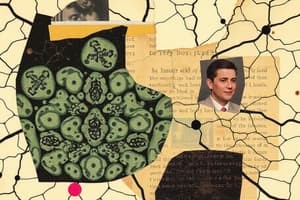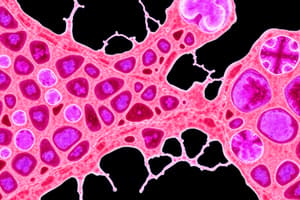Podcast
Questions and Answers
What is one of the main roles of the basement membrane?
What is one of the main roles of the basement membrane?
- Facilitate the migration of epithelial cells (correct)
- Provide structural support to muscles
- Protect underlying tissues from pathogens
- Serve as a nutrient reservoir for epithelial cells
Which component is primarily responsible for the thickness of the reticular lamina?
Which component is primarily responsible for the thickness of the reticular lamina?
- Epithelial cells
- Type IV collagen
- Reticular fibers (correct)
- Basal lamina cells
In diabetes mellitus, which of the following specifically becomes thickened?
In diabetes mellitus, which of the following specifically becomes thickened?
- Reticular lamina in connective tissues
- Basal lamina of epithelial cells
- Basement membrane of small blood vessels (correct)
- Cytoplasm of epithelial cells
What primary function does the extracellular matrix (ECM) serve in connective tissues?
What primary function does the extracellular matrix (ECM) serve in connective tissues?
What is a characteristic of epithelial tissue as described?
What is a characteristic of epithelial tissue as described?
What is the correct anatomical organization of the human body from smallest to largest?
What is the correct anatomical organization of the human body from smallest to largest?
Which of the following best describes the consistency of ECM in connective tissue proper?
Which of the following best describes the consistency of ECM in connective tissue proper?
What is the primary function of lamina lucida in the basal lamina?
What is the primary function of lamina lucida in the basal lamina?
Which type of tissue is primarily involved in the contraction and movement of the body?
Which type of tissue is primarily involved in the contraction and movement of the body?
What is the primary function of connective tissue in the body?
What is the primary function of connective tissue in the body?
Which of the following correctly describes extracellular matrix (ECM)?
Which of the following correctly describes extracellular matrix (ECM)?
What are the two basic forms of the extracellular matrix (ECM)?
What are the two basic forms of the extracellular matrix (ECM)?
What is the primary role of the basement membrane?
What is the primary role of the basement membrane?
Which layer forms the base of the basement membrane?
Which layer forms the base of the basement membrane?
What is interstitial fluid primarily composed of?
What is interstitial fluid primarily composed of?
Which of the following tissues is responsible for generating and propagating electrochemical signals?
Which of the following tissues is responsible for generating and propagating electrochemical signals?
What is necessary for magnification to be valuable?
What is necessary for magnification to be valuable?
Which type of lenses are used in electron microscopes?
Which type of lenses are used in electron microscopes?
What does the resolution power indicate?
What does the resolution power indicate?
Which of the following represents the highest resolution power?
Which of the following represents the highest resolution power?
What is the function of the condenser lens in an electron microscope?
What is the function of the condenser lens in an electron microscope?
Which magnification is achieved with a 10X objective lens and a 40X ocular lens?
Which magnification is achieved with a 10X objective lens and a 40X ocular lens?
In terms of equivalent lengths, how many nanometers are in one micrometer?
In terms of equivalent lengths, how many nanometers are in one micrometer?
What is the purpose of the projector lens in an electron microscope?
What is the purpose of the projector lens in an electron microscope?
What does electron lucent and electron dense refer to in imaging?
What does electron lucent and electron dense refer to in imaging?
Which of the following properties distinguishes Transmission Electron Microscopy (TEM) from Scanning Electron Microscopy (SEM)?
Which of the following properties distinguishes Transmission Electron Microscopy (TEM) from Scanning Electron Microscopy (SEM)?
What is a requirement for tissues and cells before using electron microscopy?
What is a requirement for tissues and cells before using electron microscopy?
What is the purpose of using heavy metal salts during sample preparation for electron microscopy?
What is the purpose of using heavy metal salts during sample preparation for electron microscopy?
What advantage does Differential Interphase Contrast (DIC) microscopy offer compared to standard phase contrast microscopy?
What advantage does Differential Interphase Contrast (DIC) microscopy offer compared to standard phase contrast microscopy?
Which resolution power is associated with Scanning Electron Microscopy (SEM)?
Which resolution power is associated with Scanning Electron Microscopy (SEM)?
In what way does phase contrast microscopy utilize light to enhance image visibility?
In what way does phase contrast microscopy utilize light to enhance image visibility?
What is a primary function of the permanent records made during an electron microscopy process?
What is a primary function of the permanent records made during an electron microscopy process?
Which of the following statements accurately describes a prokaryotic cell?
Which of the following statements accurately describes a prokaryotic cell?
What is the correct order of structural organization from smallest to largest in the human body?
What is the correct order of structural organization from smallest to largest in the human body?
Which feature is common to both prokaryotic and eukaryotic cells?
Which feature is common to both prokaryotic and eukaryotic cells?
What is the primary method of reproduction in prokaryotic cells?
What is the primary method of reproduction in prokaryotic cells?
Which of the following describes the extracellular matrix (ECM) in tissues?
Which of the following describes the extracellular matrix (ECM) in tissues?
How many different types of cells are estimated to be present in the human body?
How many different types of cells are estimated to be present in the human body?
Which of the following accurately differentiates eukaryotic cells from prokaryotic cells?
Which of the following accurately differentiates eukaryotic cells from prokaryotic cells?
Which statement is true regarding cell size in living organisms?
Which statement is true regarding cell size in living organisms?
Study Notes
Basic Tissues
- Epithelial tissue: covers exterior surfaces, lines cavities and passageways, forms glands.
- Connective tissue: binds cells and organs together.
- Muscular tissue: contracts for movement.
- Nervous tissue: generates and transmits electrochemical signals.
Extracellular Matrix (ECM)
- The non-cellular substance between cells.
- Secreted by cells.
- Composed of proteins and other molecules.
- Supports and gives structure to cells and tissues.
- Facilitates cell attachment and communication.
- Plays a role in cell growth and movement.
Types of ECM
- Basement membrane: sheet-like, found at the base of epithelial cells and surrounding muscle cells.
- Interstitial fluid: a thin layer surrounding cells, consisting of water, proteins, electrolytes, acids, hormones, and waste materials.
Basement Membrane
- Visible with a light microscope.
- Two layers: basal lamina and reticular lamina.
- Basal lamina is visible with electron microscopy, about 20-100 nm thick.
- Basal lamina consists of two layers: lamina lucida and lamina densa.
- In diabetes mellitus, the basement membrane of small blood vessels, especially in the retina and kidney, thickens.
Basal Lamina
- Secreted by epithelial cells.
- Main component is type IV collagen.
Reticular Lamina
- Formed by reticular fibers, which are thicker than the basal lamina.
- Secreted by connective tissue cells (fibroblasts).
Epithelial Tissue
- Composed of cells arranged in sheets, tightly connected.
- Avascular (lack blood vessels) but innervated (has nerves).
- Nourished by the underlying connective tissue.
Basement Membrane Functions
- Anchoring epithelial cells to connective tissue.
- Pathway for cell migration.
- Wound healing.
- Barrier between epithelial cells and connective tissue.
- Filtration of blood in the kidneys.
- Early stages of cancer called carcinoma in situ (limited to the epithelial layer).
Plasma Membrane
- Also called cell membrane.
- Surrounds the cell.
- Separates the cell's interior from the exterior.
- Provides protection for the cell.
Basal Lamina
- Thin sheet of ECM.
- Located underneath epithelial cells.
Basement Membrane
- Sheet-like form of ECM.
- Underlies epithelial cells.
- Surrounds muscle cells.
Intracellular Matrix
- The substance that fills the inside of the cell = cytoplasm.
ECM Variations
- ECM amount varies according to tissue type (minimal in epithelium, plentiful in connective tissue).
- ECM consistency varies:
- Jelly-like: connective tissue proper.
- Rubbery: cartilage.
- Hard: bone.
- Fluid: blood.
ECM Functions
- Support of cells.
- Supply of nutrition and oxygen.
- Communication between cells.
- Removal of waste products.
Human Body Organization
- Cells.
- Tissues.
- Organs.
- Systems.
Microscopy
- Total magnification power = Objective lens magnification x Eyepiece magnification.
- Resolution power: the smallest distance between two particles that can be seen as separate objects.
- The resolution power of:
- The naked eye: 0.2 mm.
- Light microscope: 0.2 micrometer (um).
- Electron microscope: 0.2 nanometer (nm).
Equivalent Lengths
- 1 mm = 1000 um.
- 1 um = 1000 nm.
- 1 nm = 10 angstroms.
Electron Microscope (EM)
- Used for high-resolution images.
- Uses a beam of electrons as the light source.
- Image is formed from the interaction of electrons with the specimen.
- Beam travels through a vacuum tube.
- Electromagnetic coils act as lenses, not glass lenses.
EM Illuminating System
- Electron gun.
- Condenser lens: focuses electrons on the specimen.
EM Imaging System
- Electromagnetic lenses (2-3).
- Screen.
- Objective lens refocuses electrons after passing through the specimen.
- Projector lens enlarges and projects the image onto a fluorescent screen.
EM Image Appearance
- Light areas (electron lucent): electrons readily pass through.
- Dark areas (electron dense): electrons are absorbed by the specimen.
EM Specimen Preparation
- Tissues and cells are embedded in resin.
- Cut into very thin sections (ultra thin sections = 0.01 of the micron).
- Sections are collected on a copper grid.
- Sections are stained with salts of heavy metals like lead nitrate and uranyl acetate.
EM Magnification and Resolution
- Magnification up to 200,000 times.
- Resolution power: 0.2 nanometer (nm).
EM Image Recording
- Images are recorded as photographs.
Types of EM
- Transmission EM (TEM): electron beams pass through the specimen. Shows internal cell structures. Resolution power: 0.2 nanometer.
- Scanning EM (SEM): electron beams are reflected from the surface of a coated specimen. Produces a 3D image. Resolution power: 10 nanometer.
Phase Contrast Microscope
- Produces visible images from transparent objects.
- Light changes speed when passing through cellular and extracellular structures.
- Objects appear lighter or darker.
- Useful for examining living cells and tissue cultures, for example, blood cells and sperms.
Differential Interference Contrast (DIC) Microscope
- An advanced version of a phase-contrast microscope.
- Used for transparent or unstained samples.
- Produces a three-dimensional image.
- Uses separate beams of light.
Studying That Suits You
Use AI to generate personalized quizzes and flashcards to suit your learning preferences.
Related Documents
Description
This quiz explores the fundamental types of tissues, focusing primarily on epithelial, connective, muscular, and nervous tissues. Additionally, it delves into the extracellular matrix, its components, and types, including the basement membrane and interstitial fluid. Test your knowledge on how these biological structures support and communicate within the body.



